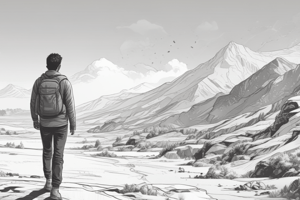Podcast
Questions and Answers
What type of boundary is formed when two tectonic plates slide past each other?
What type of boundary is formed when two tectonic plates slide past each other?
- Transform fault boundary (correct)
- Subduction zone
- Divergent boundary
- Convergent boundary
Subduction zones are formed at transform fault boundaries.
Subduction zones are formed at transform fault boundaries.
False (B)
Name an example of a transform fault.
Name an example of a transform fault.
San Andreas Fault
At the transform fault boundary, the relative motion of the plates is ________ each other.
At the transform fault boundary, the relative motion of the plates is ________ each other.
What type of boundary do plates move apart at?
What type of boundary do plates move apart at?
Match the types of plate boundaries with their descriptions:
Match the types of plate boundaries with their descriptions:
Plates slide past each other at subduction zones.
Plates slide past each other at subduction zones.
Name the three types of plate boundaries.
Name the three types of plate boundaries.
The theory of plate tectonics explains that the Earth's surface is broken into large and small lithospheric plates that are __________ constantly.
The theory of plate tectonics explains that the Earth's surface is broken into large and small lithospheric plates that are __________ constantly.
Match the following plate boundaries with their characteristics:
Match the following plate boundaries with their characteristics:
Flashcards are hidden until you start studying
Study Notes
Understanding Plate Tectonics
- Plate tectonics theory illustrates that Earth's surface consists of large and small moving lithospheric plates.
- Plates shift over time, leading to geologic events like earthquakes, volcanism, and mountain formation.
Types of Plate Boundaries
- Divergent Boundaries: Plates move apart, often forming new crust.
- Convergent Boundaries: Plates push against each other, which can lead to subduction and mountain building.
- Transform Fault Boundaries: Plates slide past one another, causing stress and potentially leading to earthquakes (e.g., San Andreas Fault).
Learning Expectations
- Understand and describe different types of plate boundaries.
- Differentiate between types of convergent boundaries.
- Identify geographical locations where various boundaries occur.
Assessment Components
- Pre-tests: Assess prior knowledge before starting new modules.
- Post-tests: Evaluate understanding after completing the module.
- Activity answer keys are provided to ensure honest self-assessment.
Important Guidelines
- Complete exercises on a separate sheet to maintain the integrity of the module.
- Read instructions carefully to ensure understanding of tasks.
- Seek help from teachers if any questions or difficulties arise.
Enrichment Activities
- Activities focus on mastering concepts related to plate boundaries, such as creating tables to classify different boundary types and illustrating movements.
- Specific guidelines for assessing the quality and completeness of models (illustrations) created by learners.
Terminology and Concepts
- Convection Currents: Forces that drive the movement of lithospheric plates.
- Subduction Zone: Formed when an oceanic plate sinks beneath a continental plate.
- Mid-Ocean Ridge: Undersea mountain range formed by divergent plate boundaries.
Final Preparation
- Review all lessons, activities, and supporting materials thoroughly before taking the final assessment to ensure a solid understanding of the topics covered.
Studying That Suits You
Use AI to generate personalized quizzes and flashcards to suit your learning preferences.




